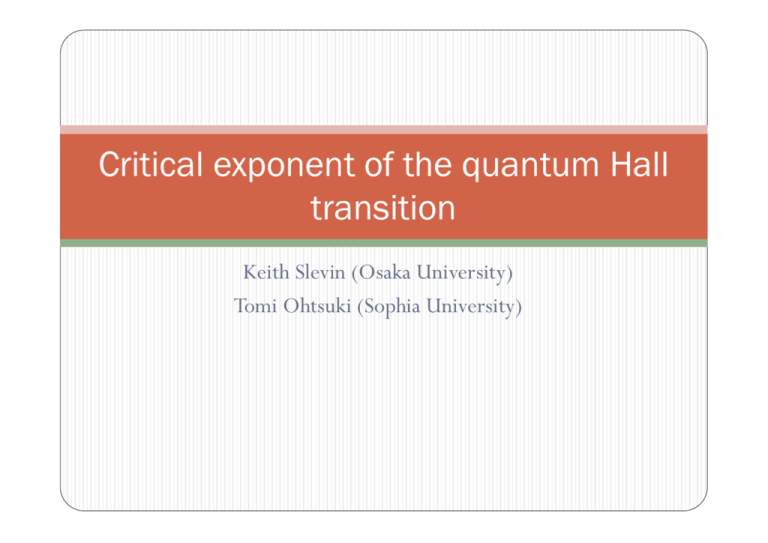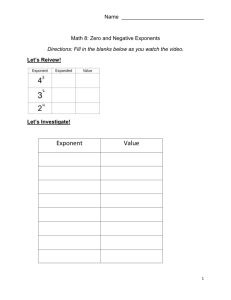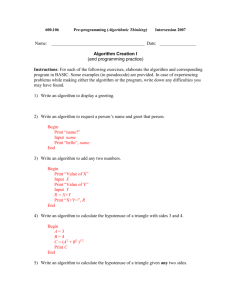Critical exponent of the quantum Hall transition
advertisement

Critical exponent of the quantum Hall
transition
Keith Slevin (Osaka University)
Tomi Ohtsuki (Sophia University)
Quantum Hall Effect
y Landau Levels (LL)
y Broadened by disorder
y All states localised except
ξ ≈ ξ 0 E − E0
−ν
for a single state at the
centre of the LL
y Localisation length
diverges at the centre of
the LL
y Divergence described by a
critical exponent
Kramer, B., T. Ohtsuki, et al. (2005). "Random network models and quantum phase transitions in two dimensions." Physics Reports 417(5‐6): 211‐342.
Li et al
Li, W., C. L. Vicente, et al. (2009). Physical Review Letters 102(21): 216801-4.
Li et al
1
= 0.42 ± 0.01
zν
z =1
ν = 2.38
The consensus
Chalker & Coddington
Huckestein & Kramer
Cain et al
(Milnikov & Sokolov)
Lee & Wang
2.5 ± 0.5
2.34 ± 0.04
2.37 ± 0.02
(7/3)
2.33 ± 0.03
“It is now generally believed that ν = 2.4’’, Li et al.
Network Model of 2DEG in B field
Chalker-Coddington Model
y Nodes described by 2 × 2
scattering matrices
y Random phases on the
links
y Energy x in units of Landau
band width
y LL center x=0
⎛ eiϕ1
S =⎜
⎝ 0
0 ⎞ ⎛ −r
⎟⎜
eiϕ2 ⎠ ⎝ t
t ⎞ ⎛ eiϕ3
⎟⎜
r ⎠⎝ 0
0 ⎞
⎟
eiϕ4 ⎠
⎛ eiϕ1′
S′ = ⎜
⎝ 0
0 ⎞ ⎛ −t
⎟⎜
eiϕ2′ ⎠ ⎝ r
r ⎞ ⎛ eiϕ3′
⎟⎜
t ⎠⎝ 0
1
0 ⎞
⎟
eiϕ4′ ⎠
1
t=
e
+2 x
+1
r=
e −2 x + 1
Transfer Matrix of CC Model
y Divide system into layers
Tl = BVl AU l
L
T = ∏ Tl
l =1
Lyapunov Exponents
y As a consequence of current conservation the eigenvalues of
the matrix
Ω = ln T †T
y occur in pairs of opposite sign
{+ν 1 ," , +ν N , −ν N ," , −ν 1} ν 1 > ν 2 > " > ν N
>0
y The Lyapunov exponents (LEs) are the limiting values
γ i = lim
L →∞
νi
2L
Smallest positive exponent
y It is usual (but not necessary) to focus on the smallest
positive exponent
γ ≡ γ ( x, N ) Γ ≡ γ N
y The output of the simulation is estimates of the LE as a
function of
y energy x
y cross section N
with specified precision σ
Γ vs x
3.0
2.5
Γ
2.0
1.5
1.0
0.5
-0.2
-0.1
0.0
0.1
0.2
Energy x
N=16, 24, 32, 48, 64, 96, 128 Precision 0.03%
Finite Size Scaling
y Localised Phase
Γ≈
N
ξ
N →∞
y Scale invariance at critical point
N ≈ constant
N →∞
y FSS law
Γ = F0 ( N α ( x − xc ) ) α =
1
ν
( xc = 0 )
Near the Critical Point
0.92
0.90
Γ
0.88
0.86
0.84
0.82
0.0
Energy x
Corrections to Scaling
y Irrelevant scaling variable
y Non-linearity of the scaling variables
Γ = F ( N α u0 ( x ) , N y u1 ( x ) )
≈ F0 ( N α u0 ( x ) ) + N y u1 ( x ) F1 ( N α u0 ( x ) )
K. Slevin and T. Ohtsuki (1999). "Corrections to Scaling at the Anderson Transition." Physical Review Letters 82(2): 382‐385.
FSS Results
N
number of data
number of parameters
chi-squared
goodness of fit
α
Γc
y
ν = 2.593
16, 24, 32, 48, 64, 96, 128
217
9
199.8
0.6
0.3857 [0.3849,0.3866]
0.78 [0.767, 0.788]
-0.17 [-0.21, -0.14]
[ 2.587, 2.598]
End of the consensus…
Slevin & Ohtsuki
Chalker & Coddington
Huckestein & Kramer
Cain et al
(Milnikov & Sokolov)
Lee & Wang
2.593 [2.587, 2.598]
2.5 ± 0.5
2.34 ± 0.04
2.37 ± 0.02
(7/3)
2.33 ± 0.03
Conformal Symmetry
y Scaling relations for 2D systems with ATs
y strips ⇔ 2D
y Position α0 of the maximum of the f(α) spectrum for a
2D system with Λc
Γ c = π (α 0 − 2 )
y Confirmed for 2D SU(2) model
y α0=2.173±0.001 (Obuse et al 2007)
y α0=2.1727±0.0001
y (applying scaling relation to Asada et al 2004)
Conformal symmetry and QHE?
y Is this relation obeyed at the QHE transition?
Obuse et al
Evers et al
Slevin et al
α0
2.2617±0.0006
2.2596±0.0004
2.248 [2.244,2.251]
y Obuse, H., A. R. Subramaniam, A. Furusaki, I. A. Gruzberg, A. W.
W. Ludwig. Physical Review Letters, 2008. 101 116802
y Evers, F., A. Mildenberger, and A.D. Mirlin. Physical Review
Letters, 2008. 101 116803
Summary
y Previous work seems to have underestimated the
exponent
ν = 2.593
[ 2.587, 2.598]
y Agreement with experiment seems to have been
fortuitous
y Further work needed to confirm conformal invariance
Slevin, K. and T. Ohtsuki, Critical exponent for the quantum Hall
transition. Physical Review B (Condensed Matter and Materials
Physics), 2009. 80(4): p. 041304-4.







